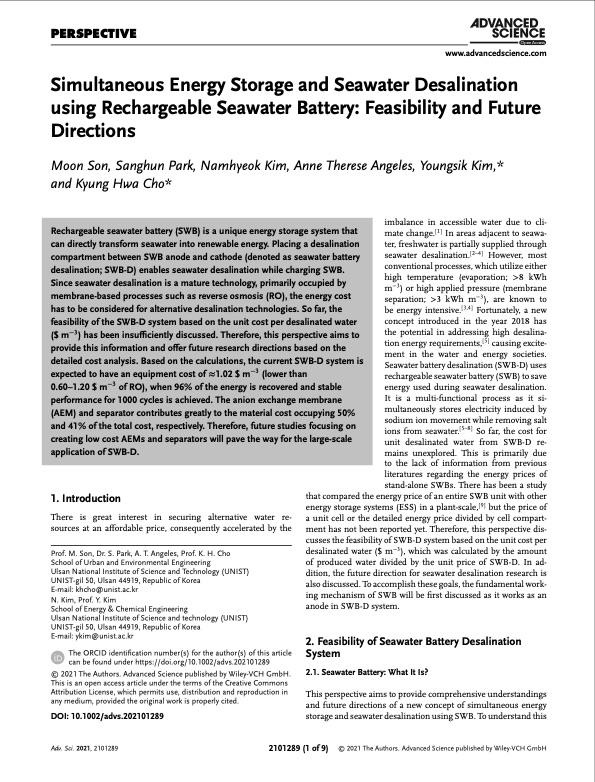
PDF Publication Title:
Text from PDF Page: 001
PERSPECTIVE Simultaneous Energy Storage and Seawater Desalination using Rechargeable Seawater Battery: Feasibility and Future Directions Moon Son, Sanghun Park, Namhyeok Kim, Anne Therese Angeles, Youngsik Kim,* and Kyung Hwa Cho* www.advancedscience.com Rechargeable seawater battery (SWB) is a unique energy storage system that can directly transform seawater into renewable energy. Placing a desalination compartment between SWB anode and cathode (denoted as seawater battery desalination; SWB-D) enables seawater desalination while charging SWB. Since seawater desalination is a mature technology, primarily occupied by membrane-based processes such as reverse osmosis (RO), the energy cost has to be considered for alternative desalination technologies. So far, the feasibility of the SWB-D system based on the unit cost per desalinated water ($ m−3) has been insufficiently discussed. Therefore, this perspective aims to provide this information and offer future research directions based on the detailed cost analysis. Based on the calculations, the current SWB-D system is expected to have an equipment cost of ≈1.02 $ m−3 (lower than 0.60–1.20 $ m−3 of RO), when 96% of the energy is recovered and stable performance for 1000 cycles is achieved. The anion exchange membrane (AEM) and separator contributes greatly to the material cost occupying 50% and 41% of the total cost, respectively. Therefore, future studies focusing on creating low cost AEMs and separators will pave the way for the large-scale application of SWB-D. imbalance in accessible water due to cli- mate change.[ 1 ] In areas adjacent to seawa- ter, freshwater is partially supplied through seawater desalination.[ 2–4 ] However, most conventional processes, which utilize either high temperature (evaporation; >8 kWh m−3) or high applied pressure (membrane separation; >3 kWh m−3), are known to be energy intensive.[ 3,4 ] Fortunately, a new concept introduced in the year 2018 has the potential in addressing high desalina- tion energy requirements,[ 5 ] causing excite- ment in the water and energy societies. Seawater battery desalination (SWB-D) uses rechargeable seawater battery (SWB) to save energy used during seawater desalination. It is a multi-functional process as it si- multaneously stores electricity induced by sodium ion movement while removing salt ions from seawater.[5–8] So far, the cost for unit desalinated water from SWB-D re- mains unexplored. This is primarily due to the lack of information from previous literatures regarding the energy prices of stand-alone SWBs. There has been a study 1. Introduction There is great interest in securing alternative water re- sources at an affordable price, consequently accelerated by the Prof. M. Son, Dr. S. Park, A. T. Angeles, Prof. K. H. Cho School of Urban and Environmental Engineering Ulsan National Institute of Science and Technology (UNIST) UNIST-gil 50, Ulsan 44919, Republic of Korea E-mail: khcho@unist.ac.kr N. Kim, Prof. Y. Kim School of Energy & Chemical Engineering Ulsan National Institute of Science and technology (UNIST) UNIST-gil 50, Ulsan 44919, Republic of Korea E-mail: ykim@unist.ac.kr The ORCID identification number(s) for the author(s) of this article can be found under https://doi.org/10.1002/advs.202101289 © 2021 The Authors. Advanced Science published by Wiley-VCH GmbH. This is an open access article under the terms of the Creative Commons Attribution License, which permits use, distribution and reproduction in any medium, provided the original work is properly cited. that compared the energy price of an entire SWB unit with other energy storage systems (ESS) in a plant-scale,[9] but the price of a unit cell or the detailed energy price divided by cell compart- ment has not been reported yet. Therefore, this perspective dis- cusses the feasibility of SWB-D system based on the unit cost per desalinated water ($ m−3), which was calculated by the amount of produced water divided by the unit price of SWB-D. In ad- dition, the future direction for seawater desalination research is also discussed. To accomplish these goals, the fundamental work- ing mechanism of SWB will be first discussed as it works as an anode in SWB-D system. 2. Feasibility of Seawater Battery Desalination System 2.1. Seawater Battery: What It Is? This perspective aims to provide comprehensive understandings and future directions of a new concept of simultaneous energy storage and seawater desalination using SWB. To understand this DOI: 10.1002/advs.202101289 Adv. Sci. 2021, 2101289 2101289 (1 of 9) © 2021 The Authors. Advanced Science published by Wiley-VCH GmbHPDF Image | Seawater Desalination using Rechargeable Seawater Battery

PDF Search Title:
Seawater Desalination using Rechargeable Seawater BatteryOriginal File Name Searched:
advs2827.pdfDIY PDF Search: Google It | Yahoo | Bing
Product and Development Focus for Salgenx
Redox Flow Battery Technology: With the advent of the new USA tax credits for producing and selling batteries ($35/kW) we are focussing on a simple flow battery using shipping containers as the modular electrolyte storage units with tax credits up to $140,000 per system. Our main focus is on the salt battery. This battery can be used for both thermal and electrical storage applications. We call it the Cogeneration Battery or Cogen Battery. One project is converting salt (brine) based water conditioners to simultaneously produce power. In addition, there are many opportunities to extract Lithium from brine (salt lakes, groundwater, and producer water).Salt water or brine are huge sources for lithium. Most of the worlds lithium is acquired from a brine source. It's even in seawater in a low concentration. Brine is also a byproduct of huge powerplants, which can now use that as an electrolyte and a huge flow battery (which allows storage at the source).We welcome any business and equipment inquiries, as well as licensing our flow battery manufacturing.| CONTACT TEL: 608-238-6001 Email: greg@salgenx.com | RSS | AMP |